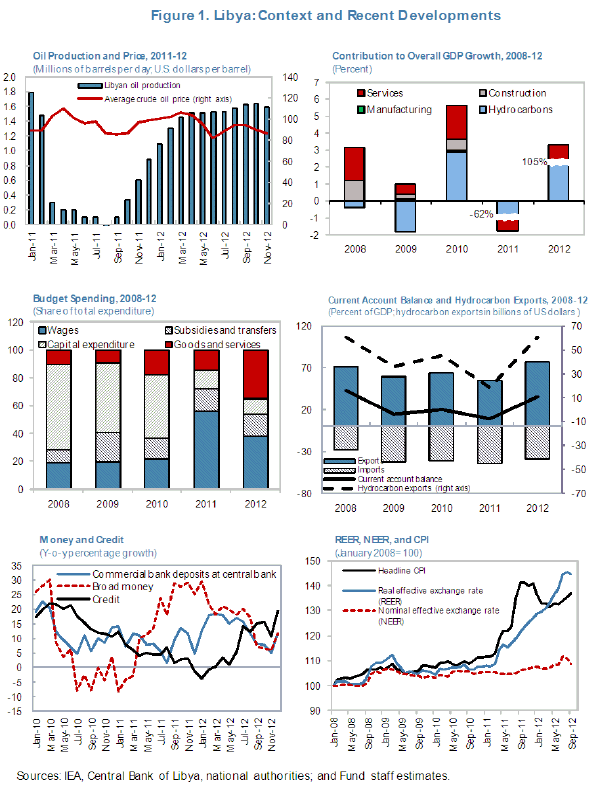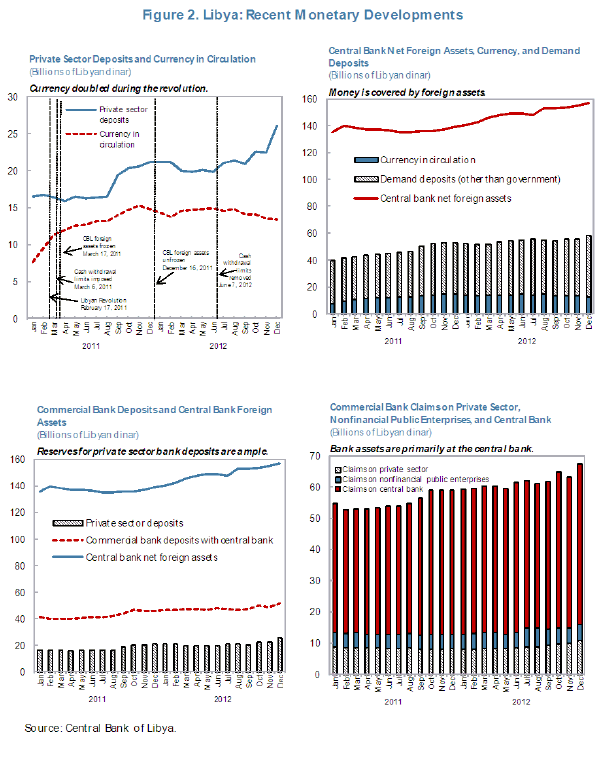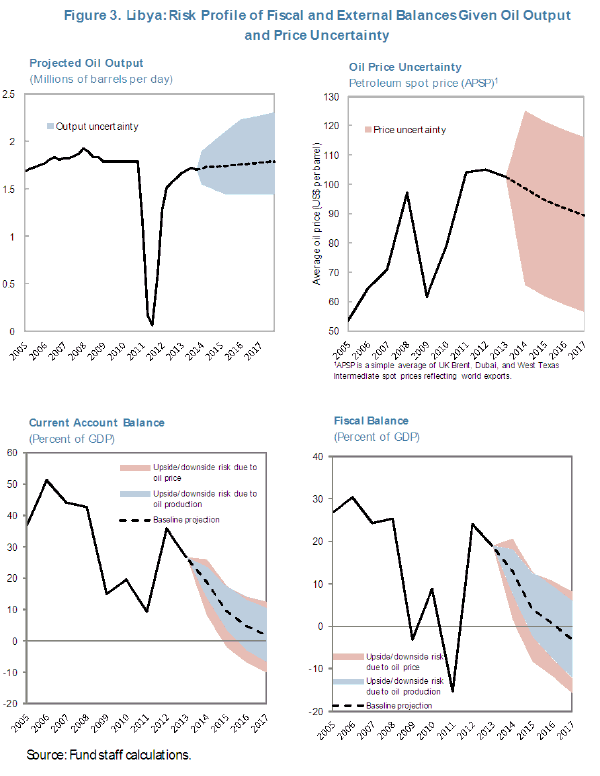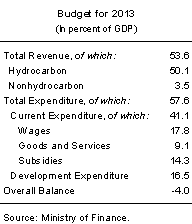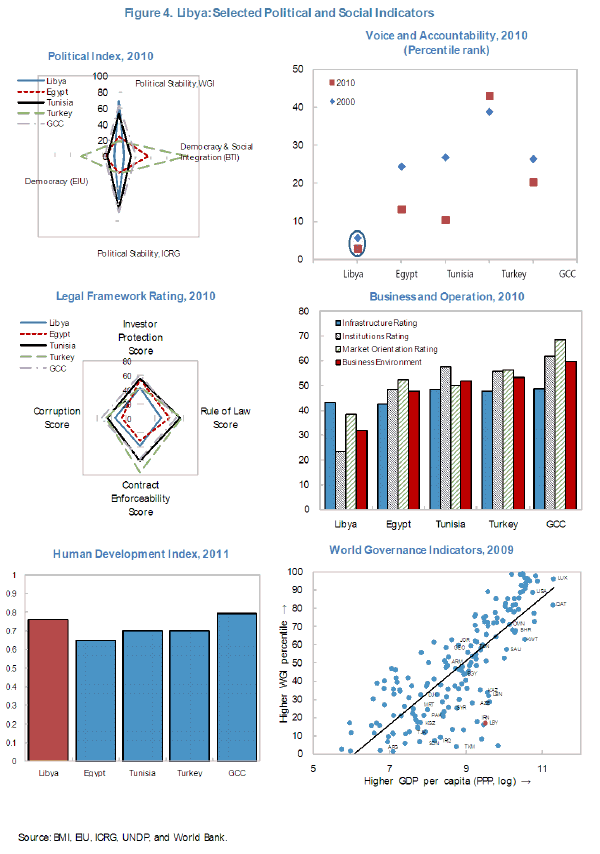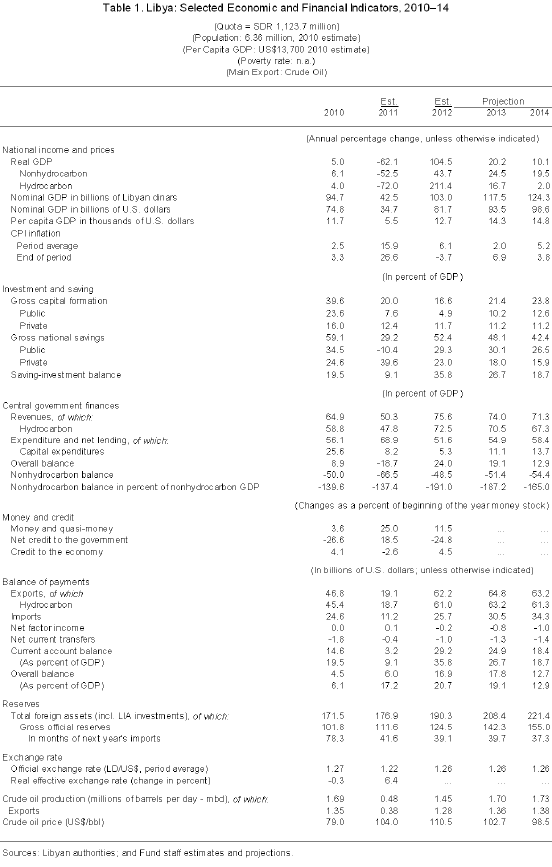Libya: 2013 Article IV Consultation Concluding Statement
March 6, 2013
Describes the preliminary findings of IMF staff at the conclusion of certain missions (official staff visits, in most cases to member countries). Missions are undertaken as part of regular (usually annual) consultations under Article IV of the IMF's Articles of Agreement, in the context of a request to use IMF resources (borrow from the IMF), as part of discussions of staff monitored programs, and as part of other staff reviews of economic developments.
Preliminary Conclusions of the IMF Mission1
Following the revolution, Libya has made major strides toward establishing a democratic system of governance. Elections were held on July 7, 2012 for the General National Congress (GNC), which international observers regarded as competitive and fair. The new interim government, installed on October 31, 2012, has a mandate to manage the transition until the ratification of a new constitution and a new round of parliamentary elections. While the Libyan economy is recovering rapidly from the conflict-induced collapse in economic activity, the high degree of dependency on volatile hydrocarbon earnings makes economic performance vulnerable to oil shocks and complicates macroeconomic management. The short-term challenges are to manage the political transition, normalize the security situation, address severe institutional capacity constraints and institute the timely compilation and dissemination of key statistics, and exercise budget discipline while maintaining macroeconomic stability. Over the medium term, the authorities should address issues including institutional capacity building, improving the quality of education, rebuilding infrastructure, putting in place an efficient social safety net, financial market development, and reducing hydrocarbon dependency through private sector-led growth.
I. Context
1. Libya remains highly dependent on hydrocarbons, which account for over 60 percent of GDP and 95 percent of revenue. While economic activity is recovering rapidly, the high degree of dependency on volatile hydrocarbon earnings makes economic performance vulnerable to oil shocks and complicates macroeconomic management. During and after the conflict, the composition of government spending became skewed toward current expenditure due to increases in the wage bill and subsidies. Although the overall balance moved from a budget deficit of 18.7 percent of GDP in 2011 to a surplus of 24.0 percent of GDP in 2012 with the restoration of hydrocarbon output, the fiscal breakeven price of oil rose from $67 per barrel in 2010 to $74 in 2012. Moreover, the nonhydrocarbon budget deficit—a more appropriate measure of the fiscal policy stance—widened from 139.6 percent of nonhydrocarbon GDP in 2010 to 191.0 percent in 2012. Although Libya can afford elevated levels of current expenditures in a transitional period, the high level of wages and subsidies, and a weak governance framework, may lead to an “entitlement mentality” and undermine the prospects for fiscal sustainability and intergenerational equity.
2. Libya faces the twin challenges of stabilizing the economy and responding to the aspirations of the revolution. The short-term challenges are to manage the political transition, normalize the security situation, and exercise budget discipline while maintaining macroeconomic stability. Over the medium term, the authorities should address issues including institutional capacity building, improving the quality of education, rebuilding infrastructure, putting in place an efficient social safety net, financial market development, and reducing hydrocarbon dependency. In addition, Libya needs to set up a governance framework linked to transparency and accountability, including anti-corruption elements that would promote private sector-led growth and improve the efficiency of public spending.
II. Recent Developments
3. The loss of hydrocarbon revenues during the conflict and UN sanctions on Libya created considerable pressures. Early in the revolution, the UN Security Council imposed sanctions on Libya making the Central Bank of Libya (CBL) unable to provide adequate foreign exchange to the market. In response to foreign exchange shortages, demand for cash, and government spending, the CBL imposed statutory limits on cash withdrawals from commercial banks. In 2011, GDP contracted by 62.1 percent and average consumer prices rose by 15.9 percent with inflation peaking at a year-on-year rate of 29.7 percent (Figure 1). By end-2012 most hydrocarbon output had been restored. Growth is estimated at 104.5 percent in 2012, with annual average inflation declining to 6.1 percent.
4. The financial situation began to normalize after the CBL regained access to its assets abroad (Figure 2). Most of the UN sanctions that had frozen Libya’s foreign assets were lifted on December 16, 2011, which allowed the CBL to provide foreign exchange liquidity to banks and help normalize commercial banking operations. The limits on cash withdrawals were eased gradually prior to their elimination on June 7, 2012, improving confidence in the banking system. In 2012, broad money grew by 11.5 percent with a modest shift from currency into deposits and credit to the private sector increased by 23.9 percent. Although the conflict will have caused asset quality to deteriorate, the systemic impact should be modest in light of the liquidity buffer provided by banks’ substantial reserves, along with limited claims on the private sector and the implicit government guarantee of loans to state-owned enterprises. Preliminary data show that nonperforming loans (NPL) increased from 20.2 percent of total loans in 2010 to 20.6 percent in 2011 and 21.0 percent as of end-2012.
5. The external sustainability assessment indicates the need for higher savings. The external sustainability approach indicates that the current account balance will be below the norm after 2014, signaling an exchange rate overvaluation and an erosion of Libya’s wealth.2 Nevertheless, in light of Libya’s hydrocarbon dependence, the need for higher government savings cannot be addressed by currency devaluation since diversification will not be achieved simply by changing the relative price of tradable and nontradable goods.
|
6. On January 6, 2013 the GNC passed a law banning interest in financial transactions but is yet to come into effect. Once the law comes into effect banks will no longer be allowed to pay interest to or receive interest from individuals. Companies and state entities will be prohibited from receiving and paying interest from the beginning of 2015. III. Outlook and Risks 7. Libya will remain hydrocarbon-dependant and private sector jobs will remain scarce for the foreseeable future. Hydrocarbon production should reach pre-conflict levels in 2013, while reconstruction expenditure and private demand should facilitate an improvement in the nonhydrocarbon sectors of the economy. Nonhydrocarbon growth will be strong, averaging almost 15.3 percent during 2013‒18, and nonhydrocarbon output will reach the pre-conflict level in 2015. Nevertheless, a significant reduction in unemployment, which is largely structural, will not occur as a result of a return to the pre-conflict status quo. Until Libya is able to generate employment opportunities in the private sector it will continue to fail to address a key underlying cause of the revolution. 8. The near-term economic outlook is generally favorable, but there are significant downside risks. Key risks to the outlook include delays in normalizing the political environment and security situation, which could be aggravated if progress to curb corruption and financial crimes is insufficient. There are security-related spillovers from neighboring countries and there is a potential for negative spillovers from Libya to the region via renewed conflict and to the world via disruption of hydrocarbon production. 9. Libya’s public finances and external current account remain vulnerable to a sustained decline in oil prices (Figure 3). With the recovery in hydrocarbon exports, the fiscal and current account surpluses in 2013 are projected at 19.1 percent of GDP and 26.7 percent, respectively. Nevertheless, the increase in recurrent expenditures poses risks to fiscal sustainability and is causing appreciation of the real exchange rate. In the medium term, necessary reconstruction and development spending will push the budget into deficit in the absence of a curb on current spending. 10. Consumer price inflation is expected to be low in the medium term, albeit with upside risks. Inflation has been falling, with a year-on-year rate of -3.7 percent in December 2012. Average inflation will be low in 2013 due to the base effect of high prices during the conflict. The availability of imports will limit inflation although rapid nonhydrocarbon growth will put upward pressure on consumer prices, particularly in light of fiscal largesse and supply bottlenecks in housing and transportation. In the absence of food price subsidy reform, higher international food prices would be mostly absorbed by the budget through increased subsidies for staples goods, thereby posing a fiscal risk with possible spillovers on prices of nonsubsidized items. 11. The hasty introduction of legislation prohibiting the payment of interest would pose risks to the financial sector and could undermine efforts to diversify the economy Once interest based transactions are prohibited by law, and without the foundations of Islamic finance in place, the environment will be less conducive for financial intermediation, thereby constraining private sector efforts to invest and create employment. Meanwhile, although the banking sector appears well capitalized, it may be vulnerable to asset quality deterioration. IV. Policy Discussions The overarching macroeconomic policy objective is to foster inclusive growth, underpinned by reforms to bolster private sector led economic diversification while ensuring transparency and accountability. Policy discussions focused on 6 main areas: (i) the near-term policy mix and macroeconomic conditions; (ii) growth and job creation; (iii) the monetary and financial sector; (iv) fiscal expenditure, public financial management, and subsidy reform; (v) transparency and statistical capacity building; and, (vi) technical assistance A. Near-term Outlook and Policy Mix 12. The mission found a favorable near-term economic outlook, but highlighted risks associated with an unanchored fiscal policy. The Libyan economy is set to grow at a robust pace, driven by private demand and government reconstruction spending. On the fiscal front, however, spending on wages and subsidies will remain high, while increasing capital expenditures will begin to erode fiscal buffers. On the monetary front, the pegged exchange rate regime will remain the policy anchor, thanks to ample foreign exchange reserves that preserve confidence in the currency. The mission welcomed the intention of the authorities to maintain the current exchange rate of the dinar, which has and continues to serve Libya well as the anchor of macroeconomic policy. 13. The mission welcomed the government’s attempt to contain current expenditures in the 2013 budget and address critical capital expenditure priorities.3 Since the revolution, the level of recurrent spending has been inconsistent with appropriate budgetary prioritization. The 2013 budget shows an overall deficit of LD 4,612 million (4.0 percent of GDP) due to a conservative estimate of hydrocarbon revenues. Hydrocarbon revenues are estimated to be LD 58,397 billion, assuming average crude oil price of $90 per barrel and production of 1.5 million of barrels per day. Nevertheless, the increase in the wage bill continues to undermine fiscal stabilization efforts, given the volatility of oil prices and a narrow nonhydrocarbon tax revenue base, which is estimated at 1.4 percent of GDP in 2013. Compared to 2012, the 2013 budget presents an increase in wages of LD 1,821 million and in subsidies of LD 2,008 million, including an earmarked reserve fund of LD 6,000 million for cash transfers. The mission recommended measures to limit current expenditure, in particular to contain increases in salaries and the number of public employees, as well as streamlining generalized subsidies. 14. The mission was encouraged by the authorities’ intention to implement a national system for the identification of individuals. The envisaged system will help to: (i) encourage the development of the formal financial sector, including fostering financial intermediation; (ii) reduce ghost workers in the civil service; (iii) provide scope to target social expenditure; (iv) improve revenue administration; and, (v) bolster the Anti-Money Laundering and Combating the Financing of Terrorism (AML/CFT) framework. B. Growth and Job Creation 15. The authorities and the mission agreed that sustainable growth requires a business environment that is conducive to private sector development. The authorities were well aware of the need to improve the business environment and are preparing to review the legislative framework to encourage development of the private sector. International indicators show a difficult business environment and lackluster infrastructure (Figure 4). In a competitiveness analysis, Libya scores poorly, at 113 out of 144 countries, below Egypt at 43 and well below the GCC average of 22.4 In other studies, Libya also scores poorly regarding the legal framework, labor market efficiency, and the business environment.5 The mission also encouraged the authorities to strengthen the AML/CFT framework in order to combat proceeds of crimes including corruption and improve the business environment. 16. The mission called for economic diversification to create employment opportunities in the private sector and reduce hydrocarbon dependency.6 Ninety eight percent of Libya’s exports are hydrocarbons, which poses a fundament challenge to macroeconomic management and limits employment growth outside the public sector. As of end-2010, unemployment was 13.5 percent with youth unemployment estimated at 25‒30 percent.7 The lack of employment opportunities for nationals can be traced back to a mismatch between the skills of workers and the demands of the private sector, as well as insufficient labor productivity, which limits demand for Libyan workers. In this connection, the authorities agreed with the mission that private sector investment is necessary to create employment opportunities sustainably. C. Monetary and Financial Sector 17. The pegged exchange rate is sustainable only as long as fiscal and monetary policies are supportive of the maintenance of the peg. The CBL should ensure that its monetary policy stance is consistent with the peg and that monetary operations are consistent with the desired stance. As of end-2012, the real rate of return on retail deposit rates was approximately negative 4 percent. Looking forward, the CBL should start to assess liquidity conditions with a view to moving toward positive real interest rates in order to increase the savings rate and forestall overheating. Furthermore, the CBL will need to develop Sharia-compliant liquidity management instruments before the payment of interest on current CBL facilities is prohibited by law. 18. The mission cautioned that implementation of a law banning interest would paralyze financial intermediation unless Sharia-compliant instruments and institutions are operational. The CBL has taken steps toward developing a dual system of conventional and Islamic banks. The mission noted that implementation of an interest ban could reduce access to credit for startups, entrepreneurs, and small and medium-sized enterprises (SMEs), and urged the authorities to develop and articulate a roadmap that is consistent with supervisory and implementation capacity, as well as the objective of promoting financial sector development. 19. The mission suggested that the authorities focus on efforts to develop a vibrant formal financial sector that caters to the needs of the economy. A number of entities currently provide financial products and services (currency exchange and transfers and short-term lending) outside of the formal banking system. In this respect the CBL has adopted procedures with respect to foreign exchange transfers abroad through the announcement of licensing requirements for exchange operators. The growth of this informal sector, operating beyond regulatory and supervisory reach, undermines public policy and potentially increases risks to financial stability and macroeconomic performance. 20. Additional structural reforms are required for the development of a growth-enhancing financial system. Financial intermediation remains rudimentary and shallow even by the modest standards of the Middle East and North Africa, reflecting a number of factors including the lack of adequate lending opportunities in nonhydrocarbon sectors of the economy and competition from specialized credit institutions (SCIs) that are directed to implement social programs. Looking forward, the mission suggested a comprehensive reform strategy aimed at: improving the legal framework; streamlining the insolvency regime; enhancing competition in the banking sector; reducing the role of state-owned commercial banks and specialized credit institutions; and, improving the credit information system to enable banks to better assess credit risk and improve access to finance. In particular, the reform strategy should seek to wind down the operations of the SCIs. 21. The mission urged the authorities to enhance regulatory and supervisory capacity. Measures to mitigate systemic risk should address vulnerabilities arising from macroeconomic developments, market infrastructure, and bank balance sheets. The mission argued that streamlining regulation while strengthening the supervisory framework remains key to promoting financial intermediation that would help underpin investment, growth, and macroeconomic stability. The mission urged the authorities to consider measures to strengthen balance sheet resilience and risk management and prevent the buildup of excessive sectoral exposures. 22. An AML/CFT Law should be brought in line with international standards, and resources should be devoted to its effective implementation. Financial sector development should be accompanied by strengthening AML/CFT supervision to ensure compliance. Adequate preventive measures and reporting to an independent and operational Financial Intelligence Unit will help limit destabilization from illicit financial flows. D. Fiscal Strategy 23. The mission highlighted that procyclical policies threaten macroeconomic stability as well as fiscal sustainability and intergenerational equity. In light of hydrocarbon dependence and the CBL’s commitment to the pegged exchange rate, fiscal policy remains the main instrument for maintaining macroeconomic stability. The mission noted that current policies will erode Libya’s wealth. The mission suggested that scaling up of development expenditure should take into account the institutional and absorptive capacity of the economy. This would ensure the efficiency of capital investment, mitigate the buildup of inflationary pressures, limit real exchange rate appreciation, and be consistent with the accumulation of precautionary savings. 24. The mission called for reprioritizing government spending to enhance growth and efficiency. Libya has a large infrastructure gap, which requires government spending to alleviate infrastructure bottlenecks to development. Some components of public spending, including on education and infrastructure, will also contribute to nonhydrocarbon growth. Reducing distortions due to high public sector wages and subsidies would improve incentives and resource allocation, leading to an increase in private capital formation and foster the growth of employment opportunities outside the public sector. The authorities acknowledged the importance of creating appropriate incentives for employment in the private sector. 25. The authorities agreed with the mission on the need to develop a rule-based medium-term fiscal framework. The adoption of a well-designed fiscal policy rule would help keep in check pressures on government spending and improve the management of oil price cycles. In the case of Libya, public finances are heavily dependent on volatile hydrocarbon earnings, with an annual budget preparation that is characterized by a short-term horizon with little reference to longer-term policies and objectives. Furthermore, beyond building fiscal buffers against exogenous shocks to the revenue stream, Libya needs to cast its spending in a framework designed to support intergenerational equity in the allocation of wealth. Accordingly, a credible fiscal policy anchor would delink the economy from oil price fluctuations, improve the management of resource wealth, and safeguard macroeconomic stability. The mission’s analysis shows that, although an “enhanced” structural fiscal balance rule—taking into account the volatility of commodity prices—provides the strongest anchor for policymaking, capacity constraints may prevent its implementation in the near future. Accordingly, the mission recommends an expenditure rule that is refined to take into account the front-loaded needs for infrastructure spending with a view to transitioning toward the adoption of the “enhanced” structural balance rule. The authorities were keen to examine the scope to institutionalize a fiscal rule in the forthcoming constitution and welcomed advice in this area. 26. The mission argued that the Libyan Investment Authority (LIA) should be integrated into the fiscal framework.8 Libya’s sovereign wealth fund (SWF) system, operating through the LIA and the budget reserve account (BRA) at the CBL, should be fully integrated into this framework, with well-defined and transparent rules determining the inflows to and outflows from the LIA and the BRA. Currently, although the LIA has an important role in macroeconomic management, it lacks a clear definition of objectives and the rules governing the accumulation, management, and use of its resources. Accordingly, the mission recommended that the LIA should function as a savings fund for future generations as well as a stabilization fund to better manage oil price cycles. In this respect, the SWF system should not participate in domestic investment projects—directly or through the Social and Economic Development Fund and the Libyan Fund for Domestic Investment and Development. Along with well-defined investment objectives to ensure consistency with broad macroeconomic policy objectives, the LIA also needs to improve transparency and accountability in its governance, consistent with international good practices. The authorities were grateful for Fund advice on the institutional arrangements for the LIA and were keen to address shortcomings in the governance framework. 27. The mission suggested the adoption of a comprehensive reform strategy to improve the public financial management (PFM) system. The core functions of the Ministry of Finance to effectively play its role of stewardship of public finances remain to be fully established. The separation of institutional responsibilities between the Ministry of Finance and the recently created Ministry of Planning for the preparation and execution of the recurrent and investment budgets poses a challenge to implementing a unified system of budget management. Fiscal forecasts—covering only the ensuing year—and the budget have yet to become effective tools for successful implementation of a fiscal strategy reflecting national policy objectives and the volatile and exhaustible nature of hydrocarbon revenues. Fiscal accounts and budget reports are prepared with substantial time lag undermining the government’s ability to monitor fiscal developments and enforce accountability in public service delivery. Moreover, government banking arrangements remain fragmented and cash resources are dispersed across numerous bank accounts. Accordingly, the mission argued that the thrust of PFM measures in the near term should be to address key priorities with a view to building the institutional capacity for more fundamental reforms. The authorities welcomed Fund advice on PFM reform as well as the opportunity to have a long-term expert advise them on reforms. 28. The mission commended the authorities on their efforts to implement subsidy reform. The Fund sent a scoping mission to Libya in April 2012 to begin work on subsidy reform. The authorities appreciated the work of the scoping mission and informed the mission that they have established high level committees to elaborate a subsidy reform strategy to move from price subsidies to cash transfers and that plans for subsidy reform were well-advanced. E. Transparency and Statistical Capacity Building 29. The authorities agreed with the mission on the need to enhance transparency throughout the public sector. Data compilation remains weak and responsibilities are spread over several agencies. Compilation of many key indicators was interrupted by the conflict and has not been restored. The authorities requested assistance from the mission in data compilation and in setting out a transparency strategy that will include the CBL, the Ministry of Finance, the SWF system, and the National Oil Corporation. F. Technical Assistance 30. The authorities requested technical assistance (TA) in the following areas: a capacity assessment program (CAP) for the Ministry of Finance, to follow the CAP for the CBL that would include a TA needs assessment; development of instruments and a regulatory framework for Islamic banking; financial market development; AML/CFT; a long-term expert on PFM; subsidy reform; resumption of work on establishment of a treasury single account; customs and tax administration; and, national accounts statistics. 1 These preliminary findings will serve as input to the Staff Report for the 2013 Article IV Consultation that will be considered by the IMF Executive Board later this year. The mission is grateful to the authorities and representatives of the private sector and civil society for very open discussions. 2 CGER-type methodologies—adapted for oil exporters—mostly indicate overvaluation. The results from the macro-balance approach are inconclusive, but for most model specifications the projected current account is below the norm. The external sustainability approach indicates that the exchange rate will become overvalued from 2014 and that the overvaluation will be almost 30 percent by 2018. The equilibrium real exchange rate approach finds that the dinar was overvalued by 15.3 percent as of November 2012. 3 The mission projected revenue of LD 83 billion with crude oil output of 1.7 million barrels per day and an oil price of $103 per barrel; capital spending was projected to be LD 13 billion. 4 World Economic Forum Global Competitiveness Report, 2012‒13. 5 The political rankings apply to the Qaddafi era and show that Libya was ranked poorly by most measures. 6 For comparison, Norway has: a population of 5 million, which is less than Libya and hydrocarbon exports of 3.5 mbd equivalent, which is double that of Libya. Nevertheless, hydrocarbons are approximately one third of exports and of revenue. 7 Data provided to a previous mission indicated that employment at end-2010 was 26 percent. 8 In November 2011 a joint Fund-Bank mission met with LIA management to provide advice on internal governance. |
IMF EXTERNAL RELATIONS DEPARTMENT
| Public Affairs | Media Relations | |||
|---|---|---|---|---|
| E-mail: | publicaffairs@imf.org | E-mail: | media@imf.org | |
| Fax: | 202-623-6220 | Phone: | 202-623-7100 | |








